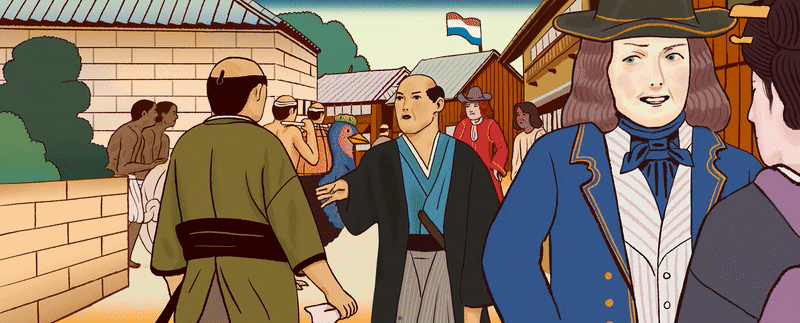The Wild West Outpost of Japan’s Isolationist Era
For two centuries, an extreme protectionist policy barred all foreigners from setting foot inside Japan…except for on one tiny island, a cramped cultural crossroads where anything could, and did, happen.
The ragged procession made its way west from Kyoto and Osaka. At its center were 26 men and boys, harangued and humiliated as they were marched 400 miles through snow and rain, before arriving at the port of Nagasaki after a grueling month. There, on February 5, 1597, all 26 of them were taken to a hill overlooking the bay and crucified. Reports paint a horrifying scene: a row of crosses on which the 20 Japanese, four Spaniards, one Portuguese and one Mexican — all Catholics — slowly bled out as they were jabbed with spears. One was a bow maker who died alongside his 14-year-old son. Nearby, the mother of another teen wept on the ground as her son’s body went limp on the cross. The youngest, a 12-year-old boy who would later be canonized as Saint Louis Ibaraki, sang while torturers cut off one of his ears.
This gruesome scene marked the dawn of a new age in Japan. It was the start of a brutal crackdown on all non-Japanese influences, a major stepping-stone toward an era when Japan effectively withdrew from the rest of the world. Fearful of European colonizers and their growing influence across Asia, Hideyoshi Toyotomi, Japan’s ruthless military dictator, had banned Christian missionaries in 1587, but there were still close to 300,000 Christians in the country. And they came from all levels of Japan’s rigidly layered society, from influential feudal lords to oppressed peasants. For the notorious Toyotomi — a man who had once ordered his own nephew to commit ritual suicide to ensure that his son would have no rival as his successor — these Christians posed too much of a threat to Japan’s political and religious status quo. Toyotomi had no qualms about killing them to protect Japanese ways.
Although Toyotomi died in a delirious stupor in 1598, subsequent shoguns continued his purges. But ridding the country of Christianity was only one part of the ultimate plan. Shogun Tokugawan Iemitsu also issued a series of sakoku (“closed country”) edicts, which included barring foreign nationals from entering Japan, as well as banning all Japanese, on threat of death, from leaving the country. With these orders, he set Japan on course for more than 200 years of complete and utter self-isolation.
Or almost.
The now closed-off country would maintain limited trading routes with the Chinese and Koreans, as well as the Ryukyu kingdom and the indigenous Ainu people, both within the borders of modern-day Japan. But Europeans would be restricted to a single patch of earth — a manmade island in Nagasaki Bay. There, these traders could interact with the Japanese, but with a few (carefully escorted) exceptions they were barred from continuing on to mainland Japan.

Called Dejima, this fan-shaped island, within view of the hill where the 26 martyrs had met their end some 40 years earlier, measured just 75 by 200 meters, about the size of a modern city block and large enough to house just a few dozen men at any given time. Though the trading post’s very existence represented fear and distrust of outsiders, it was also a concession that Japan couldn’t go it entirely alone. For the next 220 years, Dejima was the only place in the country where most Europeans could set foot, while for the few Japanese who were permitted to cross the gates from mainland Japan onto the island, it was a rare opportunity to interact with the outside world.
With much money to be made in this strategic settlement, the miniscule manmade island quickly filled with a parade of ambitious men. With them came espionage, prostitution, smugglers and scandal. Yet even as Japan’s rulers sought to keep these two cultures at arm’s length, the various people who passed through the island — Dutch (and some other Europeans in their employ) and Japanese alike — often found themselves allied together, whether by convenience, coercion or choice. In the process, this unusual crossroads mushroomed into Japan’s version of the Wild West: It became not just a trading hub where the cultures of East and West met, clashed and occasionally even fell in love, but also a place where fortunes were chased, desires sated and lives spectacularly fell apart. Debauchery, intrigue, romance: Dejima had it all.



